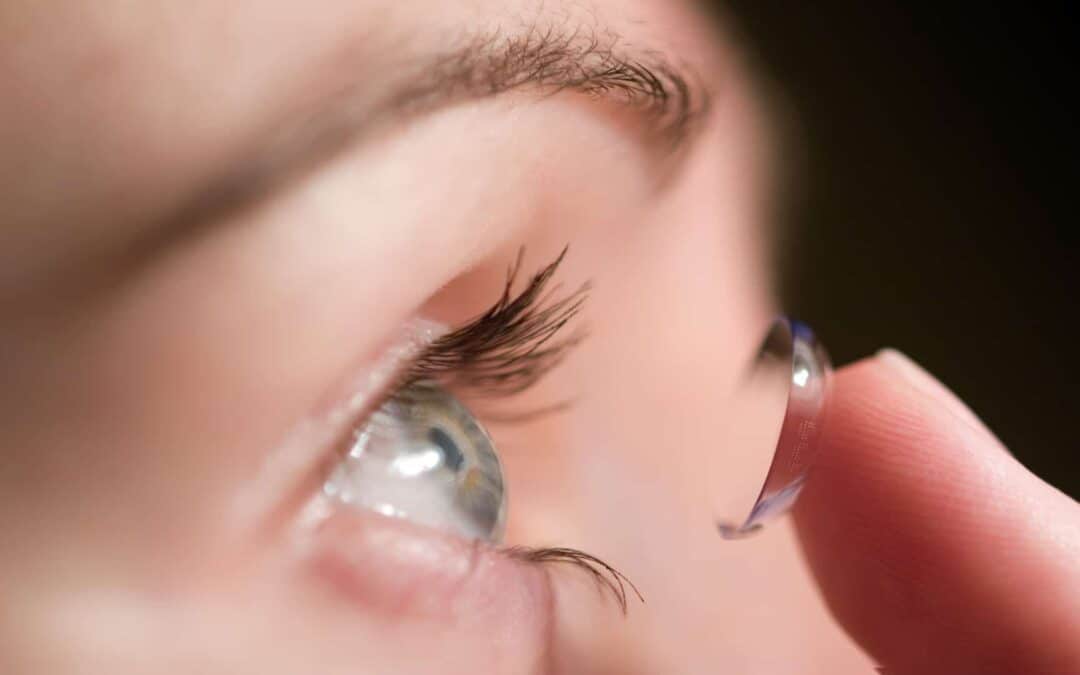Many people requiring vision correction can wear contact lenses without any problems or complications. New materials and lens care technologies have made today’s contact lenses more comfortable, safer and easier to wear. Consider the following to help assess whether they’re a choice you might consider.
How do contact lenses correct vision?
- Contact lenses are designed to rest on the cornea, the clear outer surface of the eye. They are held in place mainly by adhering to the tear film that covers the front of the eye and, to a lesser extent, by pressure from the eyelids.
- As the eyelid blinks, it glides over the surface of the contact lens and causes it to move slightly. This movement allows the tears to provide necessary lubrication to the cornea and helps flush away debris between the cornea and the contact lens.
- Contact lenses are optical medical devices, primarily used to correct myopia, hyperopia, astigmatismand presbyopia. These conditions prevent an image from focusing properly on the retina, the thin layer of tissue that lines the inner posterior portion of the eye. It consists of fine cells called photoreceptors, or rods and cones. These cells transmit light from the eye to the brain where it is perceived as vision. When light is not focused properly on the retina, the result is blurred or imperfect vision.
- When in place on the cornea, the contact lens functions as the initial optical element of the eye. The optics of the contact lens combine with the optics of the eye to properly focus light on the retina. The result is clear vision.
Would you like an alternative to wearing glasses?
- Are there special occasions when you would prefer not to wear glasses? Do you find glasses get in the way when you play sports? Contact lenses can be used intermittently for special occasions, while participating in sports or to match your fashion style, while glasses may suit your everyday needs better for activities like work or school.
- Single-use, one-day disposable contact lenses are comfortable and easy to use. They do not require cleaning, you simply throw them away daily after each use.
Contact lens wear may not be recommended if:
- Your eyes are severely irritated due to ocular allergies;
- You work in an environment with lots of dust and chemicals;
- You have an overactive thyroid, uncontrolled diabetes, or severe arthritis in your hands; or,
- Your eyes are overly dry due to a medical condition, pregnancy or medications you are taking.
After a thorough eye examination performed by your doctor of optometry, your suitability for contact lenses and the specific contact lens options that best meets your requirements will be determined.
What are the advantages of wearing contact lenses?
- Wearing contact lenses allows people to see your eyes better. Some people don’t like their appearance in eyeglasses.
- Contact lenses may allow better vision correction due to the reduced obstruction from eyeglass frames.
- They provide excellent peripheral vision.
- They don’t fog up when you come in out of the cold.
- They don’t get in the way during sports and other recreational activities.
What are the disadvantages?
- Contact lenses require adaptations. New soft lens wearers typically adjust to their lenses within a week. Rigid lenses generally require a longer adjustment period.
- Except for some daily disposable varieties, almost all lenses require regular cleaning and disinfection, a process that, although requiring only a few minutes a day, is more than some people are willing to undertake.
- Contact lenses have to be inserted and removed on a daily basis.
Your doctor of optometry will need to know: what kind of lifestyle you lead? What kind of work do you do?
- For those involved in sports and recreational activities, contact lenses offer a number of advantages. In addition to providing good peripheral vision, eliminating the problem of foggy or rain splattered lenses, and freeing you from worries about broken glasses, contact lenses also mean you can wear non-prescription protective eye wear.
- Looking sideways through the lenses of glasses leads to prismatic effects because you are not looking through their optical centers. Your eyes have to coordinate differently to cope with this. This does not happen with contact lenses because you always look through the optical center of the lenses as they move with your eye movements.
- Your occupation and work environment should also be taken into consideration. People whose work requires good peripheral vision may want to consider contacts. Those who work in dusty environments or where chemicals are in heavy use are likely to find spectacles more comfortable and safer.


